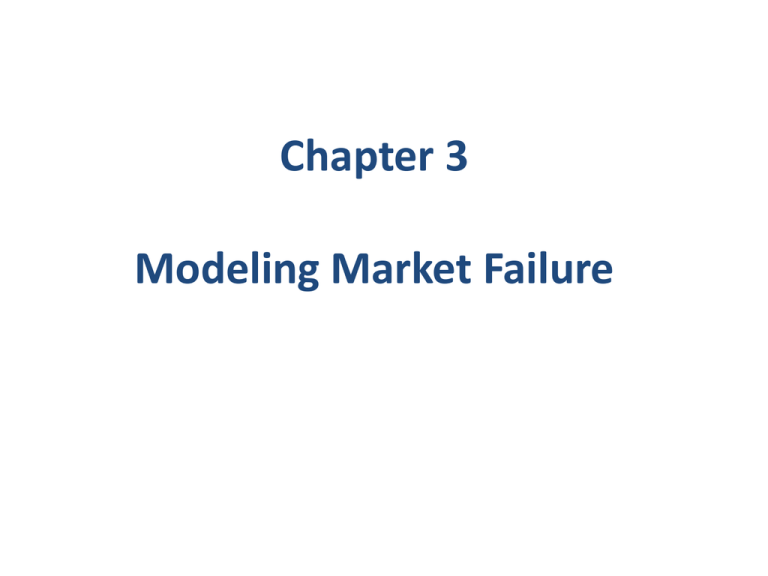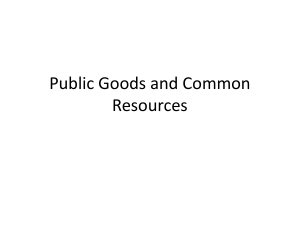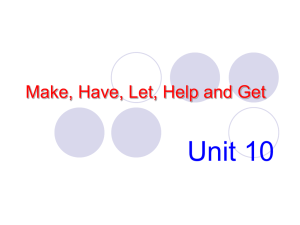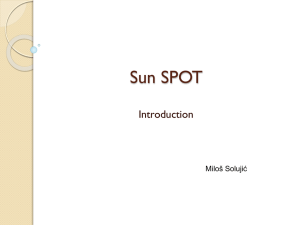Market Failure
advertisement

Chapter 3 Modeling Market Failure 1. Environmental Pollution: A Market Failure • Market failure is the result of an __________ market condition • Environmental problems are modeled as market failures using either the theory of public goods (the market is defined as “environmental quality”) or the theory of externalities (the market is defined as the good whose production or consumption generates environmental damage) 2 2. Environmental Quality: A Public Good • A public good is a commodity that is _________ ______________ and yields _____________ benefits • An example: environmental quality Two classic examples of public goods are a lighthouse and national defense. 3 Important Characteristics of Goods • A good is excludable if a person can be prevented from using it if he does not pay for it. – excludable: fish tacos – not excludable: national defense • A good is rival in consumption if one person’s use/consumption of it diminishes others’ use/consumption. – rival: fish tacos – not rival: national defense 4 Classic division of goods in economy Excludable (have to pay) Not excludable Rival in consumption (consumption diminishes its value) Not rival private goods: food clothing natural monopolies (club goods): cable TV common resources: fish in the sea environmental quality? public goods: national defense tornado siren environmental quality (our book)? Public access without any control leads to depletion/overuse/exploitation 5 3. A Public Goods Market for Environmental Quality • Air quality (measured by reductions in SO2) market • Market supply: Some number of hypothetical producers are willing and able to supply various reductions in SO2 at different price levels Market supply: P = 4 + 0.75QS 6 • Market demand: In theory, market demand for a public good is found by vertically summing individual demands – Vertical sum because we must ask consumers “What price would you be willing to pay for each quantity of the public good?” For a private good, the market demand is found by horizontally summing individuals’ demands. “What quantity of this good would you consume at each price?” 7 Demand for consumer 1: p1 = 10 – 0.12QD + Demand for consumer 2: p2 = 15 – 0.18QD Demand for consumers 1 & 2: p1 + p2 = 25 – 0.3QD Market demand: P = 25 – 0.3QD Check page 57: Figure 3.1 8 Market supply: P = 4 + 0.75QS Market demand: P = 25 – 0.3QD – Equilibrium found where 4 + 0.75QS = 25 – 0.3QD, or where QE = ___ percent and PE = $___ million 9 Page 59: Figure 3.2 P ($ millions) S 25 PE = 19 4 0 D QE = 20 Q (% of SO2 abatement) 10 Comment 1: • QE (=20%): --efficient or optimal level of abatement --not necessarily 100% (which means zero pollution) 1. Efficient level is at MB =MC 2. Zero pollution: forgone production and consumption of any good generating even the smallest amount of pollution 11 Comment 2: • Consumers are unwilling to reveal their WTP because they can share in consuming the public good even when purchased by someone else --This problem arises due to free-ridership --Result is that market demand is undefined --Consequently, allocative efficiency cannot be achieved without third-party intervention --Government might respond through direct provision of public goods --Government might use political procedures and voting rules to identifying society’s preferences about public goods 12 Public Goods • Public goods are difficult for private markets to provide because of the free-rider problem. • ________: a person who receives the benefit of a good but avoids paying for it – If good is not excludable, people have incentive to be free riders, because firms cannot prevent nonpayers from consuming the good. • Result: The good is not produced, even if buyers collectively value the good higher than the cost of providing it. 13 Example: Imagine a city in which 60,000 people are living. There is a chance to install a tornado warning system at the cost of $60,000. Each person may be prepared to pay $1. However, it is quite possible that some people will refuse to pay, and instead hope that others will pay for the system anyway, and they receive the benefit for no personal expense. The result is that it is possible no system will be installed. a tornado warning system--______________ some people--______________ the result--________________ 14 4. Environmental Problems: Externalities • An externality is a ____________ effect associated with production or consumption that extends to a third party outside the market – Negative externality: an external effect that generates costs to a third party – Positive externality: an external effect that generates benefits to a third party 15 Pollution: A Negative Externality • Example of negative externality: Air pollution from a factory. – The firm does not bear the full cost of its production, and so will produce more than the socially efficient quantity. • How govt may improve the market outcome: – Impose a tax on the firm equal to the external cost of the pollution it generates 16 5. Environmental Damage: A Negative Externality • Environmental economists are interested in externalities that damage the atmosphere, water supply, natural resources, and overall quality of life 17 Modeling a Negative Environmental Externality • Define the market as refined petroleum – Assume the market is competitive – Supply is the marginal private cost (MPC) – Demand is the marginal private benefit (MPB) – Production generates pollution, modeled as a marginal _________ cost (MEC) • Problem: Producers (refineries) have no incentive to consider the externality • Result: Competitive solution is inefficient 18 Finding a Competitive Solution Refined Petroleum Market • S: • D: P = 10.0 + 0.075Q P = 42.0 - 0.125Q, where Q is in thousands of barrels per day • Since S is MPC and D is MPB, rewrite as MPC = 10.0 + 0.075Q MPB = 42.0 - 0.125Q (P means private) • Find the competitive solution and analyze 19 Competitive Solution • Set MPB = MPC 42.0 - 0.125Q = 10.0 + 0.075Q • Solve: QC = _____ thousand; PC = $___ per barrel (C means competitive) • Analysis: – This ignores external costs from contamination – QC is too high; PC is too low 20 Finding a Socially Efficient Solution Refined Petroleum Market • Let Marginal External Cost (MEC) = 0.05Q • Marginal Social Cost (MSC) = MPC + MEC – MSC = 10.0 + 0.075Q + 0.05Q = _______________ • Marginal Social Benefit (MSB) = MPB + MEB – Assuming no external benefits, MEB= 0, so MSB = MPB • Find the efficient solution; show graphically 21 Socially Efficient Solution • Set MSC = MSB --10.0 + 0.125Q = 42.0 - 0.125Q --Solving: QE = ___ thousand; PE = $___/barrel 22 MSC, MPC, MPB Graph P ($ per barrel) 42 Page 67 MSC = MPC + MEC S =MPC PE = 26 PC = 22 10 D = MPB = MSB 0 128 160 QE QC Q (thousands) 23 • Results of negative externality --QC (160) is higher than QE (128), since the firm does not bear the full cost of its production, and so will produce more than the socially efficient quantity (overallocation of resources) --PC (22) is lower than PE (26), since MEC is not captured by market transaction 24 Important Observations • Both externality and public goods models show inefficiency of private market solution, i.e., market failure • Underlying source of failure is absence of property rights – Recall Boston Harbor application Because no one owns the atmosphere or the earth’s rivers, there is no market incentive to prevent or correct contamination of these resources. Government is needed. 25 6. Absence of Property Rights The Coase Theorem Ronald Coase, Nobel Laureate, 1991 26 Property Rights • Valid claims to a good or resource that permit the use and transfer of ownership through sale • For environmental goods, it’s unclear who “owns” rights • Economics says it’s the absence of rights that matters, not who possesses them 27 Coase Theorem • Proper assignment of property rights, even if externalities are present, will allow bargaining between parties such that efficient solution results, regardless of who holds rights – Assumes costless transactions – Assumes damages are accessible and measurable In economics, a transaction cost is a cost incurred in making an economic exchange. It includes: search and information cost, bargaining cost, and enforcement cost. 28 The Coase Theorem: An Example Dick owns a dog named Spot. _____________ externality: Spot’s barking disturbs Jane, Dick’s neighbor. The socially efficient outcome maximizes Dick’s + Jane’s well-being. – If Dick values having Spot more See Spot bark. than Jane values peace & quiet, the dog should stay. Otherwise, the dog should go. Coase theorem: The private market will reach the efficient outcome on its own… 29 The Coase Theorem: An Example • CASE 1: Dick has the right to keep Spot (Jane needs to pay Dick to get rid of Spot). Benefit to Dick of having Spot = $500 Cost to Jane of Spot’s barking = $800 • Socially efficient outcome: Spot goes bye-bye. • Private outcome: Jane pays Dick $600 to get rid of Spot, both Jane and Dick are better off. • Private outcome = efficient outcome 30 The Coase Theorem: An Example • CASE 2: Dick has the right to keep Spot (Jane needs to pay Dick to get rid of Spot). Benefit to Dick of having Spot = $1000 Cost to Jane of Spot’s barking = $800 • Socially efficient outcome: See Spot stay. • Private outcome: Jane not willing to pay more than $800, Dick not willing to accept less than $1000, so Spot stays. • Private outcome = efficient outcome 31 The Coase Theorem: An Example • CASE 3: Jane has the legal right to peace & quiet (Dick needs to pay Jane to keep Spot). Benefit to Dick of having Spot = $500 Cost to Jane of Spot’s barking = $800 • Socially efficient outcome: Spot goes bye-bye. • Private outcome: Dick not willing to pay more than $500, Jane not willing to accept less than $800, so Spot goes bye-bye. • Private outcome = efficient outcome 32 The Coase Theorem: An Example • CASE 4: Jane has the legal right to peace & quiet (Dick needs to pay Jane to keep Spot). Benefit to Dick of having Spot = $1000 Cost to Jane of Spot’s barking = $800 • Socially efficient outcome: Spot stays. • Private outcome: Dick pays Jane $900 to keep Spot, both Jane and Dick are better off. • Private outcome = efficient outcome 33 The private market achieves the efficient outcome regardless of the initial distribution of rights. 34 Solution to Externalities Government Intervention a private solution • Internalize externality by: – Assigning property rights, OR public solutions – Setting policy prescription, such as: • Set standards on pollution allowed Ch4 • Tax polluter (= MEC at QE) Ch5 • Establish a market and price for pollution Ch5 35 Consumption externalities Production externalities Positive Negative Positive Negative The benefits to the rest of society of people being vaccinated before traveling abroad Noise pollution from using car stereos The benefits to the environment that arise from the planting of woodland by a forestry company Wastes being dumped into a river by a company 36








